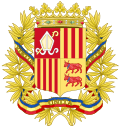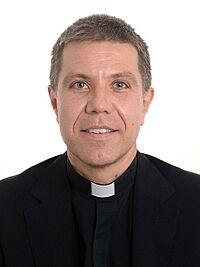Co-princes of Andorra facts for kids
Quick facts for kids Co-Princes of Andorra |
|
|---|---|
| Coprínceps d'Andorra (Catalan) | |

Coat of arms of High Authorities of Andorra
|
|
| Incumbent | |
 |
|
| Josep-Lluís Serrano Pentinat since 31 May 2025 |
|
| Co-incumbent | |
 |
|
| Emmanuel Macron since 14 May 2017 |
|
| Details | |
| Style | His Excellency |
| First monarch | Pere d'Urtx Roger-Bernard III |
| Formation | 1278 |
| Residence | La Seu d'Urgell Cathedral (Spain) Élysée Palace (France) |
| Appointer | The Pope (for the Episcopal Co-Prince) French citizens (five years, renewable once consecutively) (for the French Co-Prince) |
The co-princes of Andorra are the two leaders who share the role of heads of state for the country of Andorra. Andorra is a small country, called a microstate, located in the Pyrenees mountains between France and Spain. This special way of sharing power, known as a diarchy, started in 1278. It began with an agreement between the bishop of Urgell and the count of Foix.
Today, the bishop of Urgell, Josep-Lluís Serrano Pentinat, and the president of France, Emmanuel Macron, are Andorra's co-princes. The count of Foix's role was passed down to the French kings and then to the French president. Each co-prince chooses a special person to represent them in Andorra. The bishop's representative is Eduard Ibáñez, and the French president's representative is Patrice Faure.
Contents
History of Andorra's Leaders
How the Co-Principality Began
People say that Charlemagne, a famous emperor, gave a special paper to the people of Andorra. This was because they helped him fight against the Moors. At first, the count of Urgell was the main ruler of this land. But in 988, the count, Borrell II, gave Andorra to the Diocese of Urgell. This was in exchange for some land in Cerdanya. Since then, the bishop of Urgell, whose home is in Seu d'Urgell, has been a ruler of Andorra.
Before 1095, Andorra did not have military protection. The bishop of Urgell worried that the count of Urgell wanted Andorra back. So, he asked for help from the lord of Caboet. In 1095, the lord and the bishop signed a paper saying they would rule Andorra together. Later, the lord's granddaughter, Ermessenda, married Roger Bernat II, a French count of Foix. This made them co-rulers of Andorra along with the bishop of Urgell.
In the 11th century, the bishop of Urgell and the count of Foix had a disagreement. The country of Aragon helped them settle their fight in 1278. They signed the first paréage, which is an agreement to share power. This agreement officially created Andorra's territory and its unique system of having two rulers.
Over time, the Foix family's claim to Andorra went to the kings of Navarre. When Henry III of Navarre became Henry IV of France, he made a rule in 1607. This rule said that the king of France and the Bishop of Urgell would be the co-princes of Andorra. Later, from 1812 to 1813, the First French Empire under Napoleon took over Catalonia. Andorra became part of a French area called Sègre. After Napoleon's defeat, Andorra became independent again. The French head of state, whether a king, emperor, or president, has been a co-prince of Andorra ever since.
Andorra in the 20th Century
On July 12, 1934, a man named Boris Skossyreff tried to become "Boris I, King of Andorra." He made this announcement in Urgell. Some people in Andorra's government supported him at first. But he was arrested by Spanish police on July 20, 1934. This happened after he declared war on the Bishop of Urgell. Skossyreff was sent away and was never truly considered a ruler of Andorra.
Before 1993, Andorra did not have a written constitution. This meant the exact powers of the co-princes were not clearly written down. In March 1993, the people of Andorra voted to approve a Constitution. The two co-princes at the time, Bishop Joan Martí Alanis and President François Mitterrand, signed it into law. This Constitution made it clear that Andorra would continue to have two rulers. It also explained the exact jobs and powers of the co-princes. Before 1993, Andorra used to pay a small amount of money and some goods as a tribute to its rulers. This old custom stopped in 1993.
Andorra in the 21st Century
In 2009, French president Nicolas Sarkozy said he might stop being a co-prince. This was if Andorra did not change its banking laws. Andorra was known as a tax haven, meaning it had very low taxes and banking secrecy. The European Union also wanted Andorra to change its tax laws. From 2013 to 2016, Andorra made reforms. These changes included a personal income tax and an end to its secret banking rules.
The Co-Princes' Role Today
The Constitution of Andorra clearly explains the jobs and powers of the co-princes today. The Constitution says Andorra is a "parliamentary coprincipality." This means the bishop of Urgell and the president of France serve together as joint heads of state. The Constitution explains which powers they can use on their own. It also explains which powers need the approval of the head of the Andorran government or the leader of the Andorran parliament.
Here are some powers the co-princes can use on their own:
- They can jointly use the power to pardon people.
- Each co-prince can choose one member for the Superior Council of Justice. They can also choose one member for the Constitutional Tribunal.
- They can create services they need to do their jobs. They can also choose people to work in these services.
- They can ask for a first opinion on whether new laws or international agreements follow the Constitution.
- They must agree to the words of any international agreement before it goes to parliament for approval.
- They can take a case to the Constitutional Tribunal if there is a disagreement about their powers.
Here are some powers the co-princes can use with the head of government:
- They can call for elections or public votes.
- They can appoint the head of government.
- They can close the General Council (Andorra's parliament) before its term ends. But this can only happen at least one year after the last election.
- They can approve diplomatic representatives from Andorra to other countries. They also receive representatives from other countries to Andorra.
- They can appoint people to official positions.
- They can approve and put laws into action.
- They can formally agree to international agreements after the General Council has approved them.
The General Council gives each co-prince money each year to use as they wish. Each co-prince also chooses a personal representative in Andorra. If one co-prince cannot do their job, the Constitution says the other co-prince can lead. This happens with the agreement of Andorra's head of government or the General Council.
Some international agreements need the co-princes to be involved in their talks and final approval. The Constitution explains these in detail.
The co-princes can suggest changes to the Constitution, just like the General Council can. They cannot stop laws passed by the General Council. However, they can stop certain international agreements, as mentioned above.
When a Co-Prince's Role is Empty
If one of the co-prince roles becomes empty, Andorra has rules to keep things running smoothly. This ensures that the government of Andorra continues to work without interruption.
See also
 In Spanish: Copríncipes de Andorra para niños
In Spanish: Copríncipes de Andorra para niños
- List of heads of government of Andorra
- Prince-bishop
External links
- Representació de S.E. El Copríncep Francés
- El Copríncep d'Urgell
- Rulers.org – Andorra list of rulers for Andorra
war:Mga Igkasi-Prinsipe han Andorra

